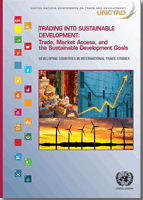
The 2030 Agenda for Sustainable Development and the Sustainable Development Goals (SDGs) suggest that countries achieve sustainable development in all three dimensions, that is, economic, social and environmental, simultaneously. In this context, international trade is expected to play its role as a means of implementation for the achievement of the SDGs.
"Means of implementation" include factors that facilitate countriesf progress towards the achievement of sustainable development, such as public and private financial resources, capacity]building, and transfer of environmentally sound technologies.
Recognizing international trade as a means for achieving socioeconomic development is not a new phenomenon.
At the establishment of the United Nations Conference on Trade and Development (UNCTAD) in 1964, the international community acknowledged that:
|
 Economic and social progress throughout the world depends in large measure on a steady expansion in international trade. The extensive development of equitable and mutually advantageous international trade creates a good basis for the establishment of neighbourly relations between States, helps to strengthen peace and an atmosphere of mutual confidence and understanding among nations, and promotes higher living standards and more rapid economic progress in all countries of the world. Economic and social progress throughout the world depends in large measure on a steady expansion in international trade. The extensive development of equitable and mutually advantageous international trade creates a good basis for the establishment of neighbourly relations between States, helps to strengthen peace and an atmosphere of mutual confidence and understanding among nations, and promotes higher living standards and more rapid economic progress in all countries of the world. (UNCTAD, 1964)
|
In practice, however, it remains a considerable challenge to trade policymakers to map out interlinkages between trade policy and sustainable development, let alone to ensure that trade policy outcome positively influence sustainable development. In this increasingly globalised world, achieving the SDGs as universal agenda requires policy coherence at all (national, regional and global) levels, where trade policy and its policy and institutional interfaces with all the SDGs is one part of the jigsaw.
This report examines various interactions between trade policy, with a specific focus on market access conditions, and factors that constitute the basis for achieving sustainable development. Market access conditions vis-avis imports are determined by a combination of border measures and gbehind the borderh measures, both of which add costs to the price of an imported product. By generating significant impact upon consumer welfare and the competitiveness of domestic industries, market access conditions in international trade thus are a key determinant of the effectiveness of trade as a means of implementation.
Chapter I provides an overview of the report by examining to what extent sustainable development concerns are integrated into todayfs trade policymaking. The chapter first looks into how those concerns are treated in trade agreements at multilateral, regional and bilateral levels. It then discusses opportunities as well as challenges in using market access conditions to meet sustainable development objectives.
Chapter II discusses the use of tariffs for trade and development purposes, and provides comprehensive statistical information on the trade-related gindicatorsh for the reviewing and monitoring of the implementation of the 2030 Agenda.
Chapter III discusses how NTMs can act as an important gpolicy interfaceh within the trade-SDG nexus at home as well as that of trading partners. The majority of NTMs are domestic regulations that cater for social and environmental development objectives. The chapter discusses ways to achieve synergies between policy measures for achieving the SDGs and enhancing trade flows across countries.
Chapter IV presents recent evidence on the importance of connectivity, especially maritime connectivity, to international markets. Enhancing physical connectivity to markets is one of the most effective policy actions to complement market access improvement for both exports and imports.




